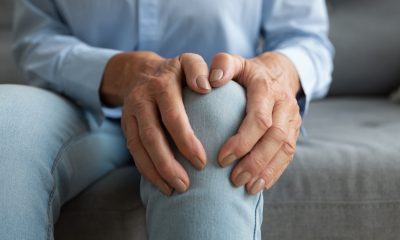News
Innerva: the UK wellness company meeting the demand for active ageing

Howard Blackburn knows exactly why the company to which he has devoted more than 30 years of his working life, is in his opinion a game changer for those looking to keep fit in the second half of their lives.
“Because we are the only product, the only manufacturer, who has focused all of its efforts on this particular age group, the only one that has invested in understanding the needs of this age group, and we are the only one that has worked with three different universities in understanding this age group’s needs and creating a solution that delivers the right package, in the right way, in the right balance.
“So, we believe we are a game changer because we have taken up the challenge of meeting the needs of the older adult and providing the perfect solution. We believe we are a game changer because we are the only people who can do this properly and effectively. And we are absolutely confident we are a game changer because of the wonderful feedback we get.
“The magic we have is that we give people a helping hand who may have limited mobility or lack the confidence to exercise. We take away the fear of not being able to exercise and very gradually we give older people the confidence to stay fit and healthy.
“We feel proud that we are delivering the right thing, and we know the world and the market will come round to seeing this.”
The company Howard is talking about is UK-based Innerva. The Yorkshire firm bills itself as the world’s leading provider of power-assisted exercise equipment. It’s a bold claim. Innerva is by no means the only manufacturer of resistance fitness equipment.
But Howard says what makes Innerva different from its rivals is that it’s dedicated to helping the over 55s – and especially those with a range of long-term health conditions – get fit, stay fit, and age well.

Howard Blackburn, CEO of Innerva.
The 65-year-old, who has recently stepped into a new role as Innerva’s CEO after handing over the day-to-day running of the company to new managing director, Jon Hymus, says: “We are not in the market of making fit people fitter. They are already able to get to the gym and are working out. We can’t do anymore for them.
“The people we are wanting to help are those who want to get fit but maybe don’t like the thought of going to a gym because on past experience they have found the environment too intimidating, the machines too difficult to use, especially if they have mobility or health issues, and feel they don’t fit into the traditional gym scenario.
“But as people are living longer, it is vital we all try to age as healthily and actively as we can. And here at Innerva we are leading the way in providing the solutions people need to achieve that.”
Innervra works with leisure, care, rehabilitation and therapy centres across the UK, Europe and Australia, and is looking to expand into the Middle East and the US.
Just like any other gym equipment manufacturer, the firm offers a range of individual and circuit exercise machines targeting different areas of the body. So whether a user is looking for a full body workout or just to tone up their leg or arm muscles, Innerva has an option.
But unlike conventional exercise machines, Innerva’s range doesn’t rely exclusively on muscle power. Instead the machines are powered by an electronic system that enables users to work passively or actively, depending on their level of fitness and abilities.
All the equipment has been designed to provide safe exercise to all the major muscle groups and over time will help to retrain muscle patterns, improve circulation, and ultimately fitness.
It makes power-assisted exercise the perfect choice for older people with mobility and health issues, or for those who may just be looking to get fit after a long period of inertia.
Whilst Howard has been involved in the power-assisted exercise market since the late 1980s, Innerva is actually a new name in the field.
The company which is based near the West Yorkshire town of Holmfirth – fittingly the location of the classic BBC comedy Last of the Summer Wine centred around three elderly men reminiscing about their childhood days, and trying to stay young by engaging in madcap feats not usually undertaken by people their age – has recently undergone a name change that Howard says better reflects its unique selling point, or USP.
 Innerva actually started out life as Shapemaster in 1989, perhaps best known for its toning tables. Howard, an engineer by training, had joined the company to work on developing and manufacturing a UK version of the toning tables that had taken America by storm.
Innerva actually started out life as Shapemaster in 1989, perhaps best known for its toning tables. Howard, an engineer by training, had joined the company to work on developing and manufacturing a UK version of the toning tables that had taken America by storm.
He says: “There was a boom in toning tables. Power-assisted exercise was the thing. At that time it was mainly boutique centres and it was like a ladies only thing.
“I joined the company and at the time I didn’t know much about business. I was just an engineer. I had never even heard of these exercise machines, but I was a confident engineer and thought I could make anything. I had always been interested in things that move, so it was like a calling for me.”
Howard rescued the company to form Shapemaster Global. As the market moved away from toning tables, the company redesigned its offering to include seated power-assisted fitness machines for the care, therapy and rehabilitation markets. It has continued to innovate and evolve over the years.
But people still associated Shapemaster with toning tables. So last year Howard changed his company’s name to Innerva. “I was looking through the planets, and spotted one called Minerva. I took the ‘M’ off it and it became Innerva. It sounded like innovate and it just sounded right.
“The V as a Roman numeral also represents the five elements of healthy ageing, those components of fitness and physical performance which are central to sustained wellbeing in older people: cardio, flexibility, balance, strength and mental wellbeing.”
To keep ahead of the game, Innerva’s products have been evaluated in numerous university-led studies.
In one recently conducted at Sheffield Hallam University’s Advanced Wellness Research Centre (AWRC), muscular, biochemical and physiological responses to power-assisted exercise amongst healthy older adults was measured. The results conclusively showed the immediate beneficial physical responses to exercising on Innerva equipment, and hence the positive impact on the five elements of healthy ageing, thus helping in maintaining and improving the quality of everyday living.
Innerva has also been the recipient of £1.1m in funding as part of the UKRI’s Healthy Ageing Challenge. The firm is now partnering with the AWRC as well as Manchester Metropolitan University to explore the challenges older adults face in accessing physical activity and how public sector leisure providers can successfully engage with the market.
Innerva will also develop new solutions that promote active ageing, giving UK leisure operators the tools to help people in their local communities remain independent and socially connected for as long as possible.
The global population is ageing. By 2035, more than half of adults in the UK are expected to be over the age of 50 and the number of people aged 85-plus is projected to double by 2050. But it’s a double-edged sword. Whilst people’s life expectancy has increased, the number of years they are living in poor health is sadly also growing.
Being physically active is one of the most effective ways to improve quality of life in later years – and help relieve the burden on overstretched health services.
“I’ve done research on what happens to people who have had a stroke, who have had a fall, and it’s quite staggering the amount of money the NHS spends on acute care, such as mending someone with a broken hip. Something like 50% of people don’t make it to year two. There are some shocking statistics. But if they do, I think the cost of a fall can be more than £60,000 to the NHS, where there is a fracture involved.
“If you look at the whole sector, falls make up more than 50% of A&E admissions in the over 60s, and the NHS spends something like £5m a day on falls, but a lot less on fall prevention. It’s the same if you look at stroke, diabetes, chronic obstructive pulmonary disease, in fact anything that comes with a measure of preventability.
“The NHS is saying that 80% of these conditions are preventable with better health, and part of that better health is from exercise.
“It didn’t take long to put two and two together to think that if someone could come up with some means of providing exercise, then if you work out what 80% of the cost of all these conditions is, it is actually £20bn. So imagine being able to save the NHS £20bn a year. The NHS costs around £200bn a year to run, so 10% is a massive amount.
“So I thought, here’s a mission, something to get my teeth into. I started to think about looking for a solution for older adults, for that age group for whom inch loss isn’t really important anymore but mobility and quality of life are.”
As he reaches retirement age himself (although he has no desire to hang up his boots just yet), Howard says his belief that everyone has the right to healthy ageing, has never been stronger. Under Jon Hymus’ leadership, Innerva will continue to partner with universities and develop and invest in new technologies and innovations to help people age better.
Howard says: “We’re now nearly three years into the United Nations Decade of Healthy Ageing, a global movement to improve the lives of older people.
“In my mind, there has never been a greater need for products and services that help people age well. Research and development is and always has been the cornerstone of this business, and going forward we will ensure Innerva remains at the forefront of innovation in the active ageing sector.”
News
FDA greenlights simple Alzheimer’s test

The US Food and Drug Administration (FDA) has approved a second blood test to detect Alzheimer’s disease, potentially speeding diagnosis for millions of patients.
The Elecsys pTau181 test measures protein levels in blood plasma that act as biomarkers for the degenerative brain disorder, offering a simpler alternative to costly brain scans for people aged 55 and over with symptoms of cognitive decline.
The approval marks another step toward making Alzheimer’s detection more accessible through routine blood testing rather than specialist imaging that can take weeks or months for diagnosis.
Developed by Swiss biotech company Roche with Eli Lilly, the test builds on evidence that certain blood proteins can indicate brain changes linked to Alzheimer’s disease.
The pTau181 protein it measures is a biomarker — a biological indicator of disease activity.
“By bringing Alzheimer’s blood-based biomarker testing into primary care, we can help patients and their clinicians get answers sooner to support them earlier in their journeys,” said Brad Moore, CEO and president of Roche Diagnostics North America.
The FDA approved the first Alzheimer’s blood test, Lumipulse, earlier this year.
That test, made by Japanese company Fujirebio, detects different protein biomarkers linked to the disease.
Alzheimer’s is currently diagnosed using brain scans that detect toxic protein build-up and other hallmarks of the disease. These procedures are expensive, often involve long waiting times, and are not widely available.
Blood tests could make early screening easier in primary care, though experts stress they cannot provide a definitive diagnosis on their own.
“This is another important step toward expanding access to Alzheimer’s disease diagnostic tools,” said Dr Joanne Pike, president and CEO of the Alzheimer’s Association.
“At the same time, it is important to understand this test is designed to rule out the presence of amyloid plaques. It is not a test that will give an Alzheimer’s disease diagnosis, nor is it a standalone tool for detection.”
Amyloid plaques are abnormal protein deposits that form between brain cells and are a hallmark of Alzheimer’s.
The blood test helps determine whether these plaques are likely present, guiding doctors on whether further testing is needed.
Roche said a clinical study involving more than 300 participants showed the test correctly identified people without Alzheimer’s signs in nearly 98 per cent of cases.
his accuracy could help reduce unnecessary brain scans and related costs.
Researchers at UC San Diego recently reported that rises in blood proteins following brain inflammation and nerve cell damage were linked to cognitive decline — evidence supporting development of blood-based early detection tools.
Dr Richard Isaacson, who established one of the first Alzheimer’s prevention clinics in the US, told CNN that additional blood tests would likely be needed to give a full picture of brain health.
“This single Roche test is looking at pTau181 as a single protein marker,” he said.
“But for people who are at risk for Alzheimer’s, to truly have the best accuracy and the most granularity to understand what’s going on, we’re going to need a panel of tests.
“And then we’re going to need to follow these tests over time.”
The Alzheimer’s Association said the test could help avoid unnecessary and expensive diagnostic procedures.
The Elecsys pTau181 test is designed to be used alongside clinical evaluation and other diagnostic tools, not as a replacement for full medical assessment.
Patients with positive results would typically undergo additional testing to confirm a diagnosis.
Both approved blood tests represent progress in improving Alzheimer’s detection, though experts emphasise that diagnosis still requires a combination of clinical, imaging and laboratory assessments.
As blood-based biomarker research advances, scientists hope combining several markers will give a clearer picture of brain health and disease progression — potentially allowing earlier intervention and better patient outcomes.
Insights
Roundup: Atlas maps molecular fingerprints of health, disease and ageing

Age Tech World explores the latest research developments in the world of ageing and longevity.
Pan-disease atlas maps molecular fingerprints of health, disease and ageing
A new study has mapped the distinct molecular “fingerprints” that 59 diseases leave in an individual’s blood protein, which would enable blood tests to discern troubling signs from those that are more common.
An international team of researchers mapped how thousands of proteins in human blood shift as a result of ageing and serious diseases, such as cancer and cardiovascular and autoimmune diseases.
The Human Disease Blood Atlas also reveals that each individual’s blood profile has a unique molecular fingerprint, which changes through childhood and stabilises in adulthood.
This provides a baseline for comparison that healthcare providers could one day use to flag early deviations.
The study used machine learning that enables information critical for building blood panels that would not misclassify patients in real world settings.
The mapping of molecular fingerprints of disease is a crucial step for building blood tests that work in the clinic, the researchers say.
For example, many proteins that rise in cancer or autoimmunity also rise in infections, reflecting shared inflammatory pathways, while other patterns such as liver-related conditions are clustered by organ systems.
The Disease Blood Atlas offers a path to solve the problem of identifying reliable, reproducible biomarkers for diseases – a process that to date has typically involved comparing new protein markers against a control, that is, a healthy profile.
The researchers point to the study’s success in identifying common biomarkers that are consistently altered in various conditions.
These shared molecular features could serve as universal diagnostic, prognostic or therapeutic targets.
Among the findings was that specific protein profiles can change substantially as individuals approach a cancer diagnosis, with some proteins showing higher concentrations prior to diagnosis.
These findings suggest more study should be devoted to investigating the potential of using proteomics for early cancer detection.
Aging Well with AI report explores AI and the healthcare workforce
The “Aging Well with AI: Empowering Care through Innovation” whitepaper has been published, the first in a two-part white paper series exploring how artificial intelligence (AI) can strengthen the U.S. healthcare workforce and improve access to care.
As the US confronts a historic shortage of healthcare workers alongside a rapidly ageing population, the report outlines specific ways AI can reduce strain on clinicians and improve outcomes for older adults, without eroding the human relationships that are essential to high‑quality medicine.
HealthFORCE, a national alliance of leaders dedicated to addressing the root causes of America’s healthcare workforce crisis, along with the American Academy of Physician Associates (AAPA) and West Health, published the report.
The paper highlights five opportunities for AI to extend the healthcare workforce and improve care for older adults and calls on policymakers, health systems and innovators to invest in geriatric-focused tech innovation and prioritise AI tools that serve older adults.
It also calls for incentives for cross-specialty training in ageing care and AI use for all frontline providers, the establishment of national standards for AI integration across state lines and care settings and the promotion of interoperability and support value-based payment models that reward continuity, efficiency, and prevention.
The upcoming second report will focus on how AI can augment care delivery across all patient populations and help address the projected shortfall of 3.2 million healthcare workers by 2026.
It is set to be released later this month.
Lifelong companionship protects ageing rat brains from cognitive decline
A new research paper shows that aged rats who lived in socially enriched environments throughout life retained better memory and cognitive flexibility than those housed alone.
This study highlights the importance of social interaction in protecting the ageing brain.
Cognitive decline, such as memory loss and reduced problem-solving ability, affects many people over the age of 65.
While many factors contribute to age-related cognitive decline, this study suggests that one key factor may be surprisingly simple: long-term social connection.
To explore how social interaction might influence memory performance and brain activity, the researchers designed a study using rats as a model for ageing in humans.
The team compared three groups of rats: young adults, aged rats housed alone, and aged rats housed socially in groups.
All groups had access to the same physical enrichment, such as exercise and stimulating objects, but only some experienced lifelong social companionship.
The team tested these animals on a complex memory challenge known as the biconditional association task, which requires animals to make context-based decisions, an ability that typically declines with age.
The results showed that aged rats living in social groups performed just as well as young adults on the memory task, while those housed alone showed significant impairments.
Socially housed rats also made fewer working memory errors and required less effort to complete cognitive tasks, suggesting not only better performance but more efficient brain function.
These benefits were not observed in aged rats who received only environmental enrichment without social interaction.
Brain imaging revealed additional differences between the groups.
Socially housed aged rats showed increased activity in the hippocampus, particularly in the CA3 region, which plays a key role in forming and separating memories.
In contrast, aged rats that lived alone had lower activity in this region, which may explain their poorer performance.
Interestingly, socially housed rats also showed reduced overactivity in the anterior cingulate cortex, a brain area involved in attention and decision-making, suggesting a more balanced and efficient neural response.
This research provides new insight into how lifelong social experiences shape brain health during ageing.
While earlier studies have shown that physical activity and cognitive stimulation help preserve cognitive function, this study identifies social interaction as an independent and powerful protective factor.
The findings are consistent with human studies showing that older adults who remain socially active tend to experience slower cognitive decline and stronger brain function.
Overall, these results emphasise that brain ageing is not inevitable but may be influenced by our social environments.
This research suggests that fostering lifelong social connections could be a critical, low-cost strategy to protect memory and mental flexibility in older adults.
Service dogs slow cellular ageing in female veterans
New research has found that service dogs may help slow biological ageing in women.
This groundbreaking study, focused on female veterans in the United States, is among the first to examine the impact of working with service dogs on this often-overlooked population.
By measuring biological indicators of stress, the researchers have uncovered a key insight: the way stress is felt emotionally doesn’t always reflect how it affects the body at a cellular level.
Researchers conducted the study involving female veterans with post-traumatic stress disorder (PTSD), but instead of receiving service dogs, these women volunteered to train them for fellow veterans in need, offering support not just to others, but potentially to themselves.
The study examined whether this purposeful, mission-driven activity could reduce both biological and psychological stress, and whether previous combat exposure influenced those effects.
Until now, the emotional and therapeutic benefits of such unique relationships have been largely unexamined in female veterans.
To measure biological stress, researchers looked at telomere length (a marker of cellular ageing) using saliva samples, and heart rate variability (HRV), a sign of nervous system balance, using wearable monitors in participants in the service dog training program group or a comparison group that watched dog training videos.
Psychological stress was assessed using validated questionnaires measuring PTSD symptoms, perceived stress, and anxiety at multiple points during the study.
Results evealed promising biological benefits associated with service dog training, particularly for veterans with combat experience, while improvements in psychological symptoms were seen across all participants, regardless of the intervention.
One of the most striking findings involved telomere length. Veterans who participated in the dog-training programme showed an increase in telomere length, suggesting a slowing of cellular ageing.
In contrast, those in the control group exhibited a decrease in telomere length, indicating accelerated ageing.
Combat experience significantly influenced these results: veterans with combat exposure who trained service dogs experienced the greatest gains in telomere length, whereas those with combat exposure in the control group saw the most pronounced declines.
On the psychological front, both groups, those who trained dogs and those in the control group, reported significant reductions in PTSD symptoms, anxiety and perceived stress over the eight-week period.
However, these mental health improvements were similar across groups, suggesting that simply participating in the study and receiving structured attention may have offered therapeutic value.
Unlike the biological findings, psychological outcomes did not appear to be affected by combat exposure.
The study also suggests that the skills learned during service dog training such as positive reinforcement and reading animal behavior may have strengthened participants’ bonds with their own pets at home, offering additional emotional support.
Unlike general volunteering, service dog training uniquely blends emotional healing with building a close relationship between veterans and their animals, providing therapeutic benefits that go beyond typical community engagement.
Female veterans aged 32 to 72 were randomly assigned to either the service dog training program group or a comparison group that watched dog training videos.
Both groups took part in one-hour sessions each week for eight weeks. Researchers measured outcomes before, during and after the programme.
These findings provide early evidence that non-pharmacological interventions – such as service dog training – may help reduce the physical toll of stress and slow cellular ageing in female veterans.
News
Cholesterol-lowering drugs could reduce dementia risk

People with genetic variants that naturally lower cholesterol were found to have up to 80 per cent lower dementia risk in a study of more than one million participants.
The research analysed data from Denmark, England and Finland to assess how genes that mimic the effects of cholesterol-lowering drugs such as statins and ezetimibe influence dementia risk.
Scientists found that reducing blood cholesterol by one millimole per litre was linked to as much as an 80 per cent reduction in dementia risk for certain drug targets, suggesting possible benefits from cholesterol-lowering treatment.
The researchers used a method known as Mendelian randomisation, which allows scientists to study the effects of lowering cholesterol while avoiding confounding factors such as diet, weight and other lifestyle habits.
Dr Liv Tybjærg Nordestgaard led the research while at Bristol and now works at Copenhagen University Hospital–Bispebjerg and Frederiksberg hospital.
Dr Nordestgaard said: “What our study indicates is that if you have these variants that lower your cholesterol, it looks like you have a significantly lower risk of developing dementia.”
Some people are born with genetic variants that naturally affect the same proteins targeted by cholesterol-lowering drugs such as statins and ezetimibe.
By comparing these individuals with those without such variants, the researchers were able to measure differences in dementia risk.
Mendelian randomisation uses genetic variation as a natural experiment.
Because genes are inherited randomly at conception, this method can mimic randomised clinical trials and offer stronger evidence for cause-and-effect relationships than traditional observational research.
The findings suggest that having low cholesterol, whether due to genetics or medical treatment, could help reduce the risk of developing dementia. However, the study does not provide definitive evidence about the effects of the medicines themselves.
One of the main challenges in dementia research is that symptoms typically appear later in life, requiring decades of follow-up to detect meaningful changes. This makes long-term clinical trials difficult to conduct.
The biological link between high cholesterol and dementia is not yet fully understood. Dr Nordestgaard suggested that atherosclerosis — the build-up of cholesterol in blood vessels — may play a key role.
Dr Nordestgaard said: “Atherosclerosis is a result of the accumulation of cholesterol in your blood vessels.
“It can be in both the body and the brain and increases the risk of forming small blood clots—one of the causes of dementia.”
Blood clots can block small vessels in the brain, leading to vascular dementia — the second most common form of the condition after Alzheimer’s disease.
Even small clots can damage brain tissue over time and contribute to cognitive decline.
The study used data from large genetic research projects including the UK Biobank, the Copenhagen General Population Study, the Copenhagen City Heart Study, the FinnGen study and the Global Lipids Genetics Consortium.
These resources provide genetic and health information from diverse populations, improving the reliability of the findings across different ethnic and geographical groups.
The UK Biobank includes data from around 500,000 participants aged 40–69, while the Copenhagen studies have tracked Danish populations for several decades, providing detailed health records for long-term analysis.
“It would be a really good next step to carry out randomised clinical trials over 10 or 30 years, for example, where you give the participants cholesterol-lowering medication and then look at the risk of developing dementia,” Dr Nordestgaard added.
Such trials would provide direct evidence about whether cholesterol-lowering drugs can prevent dementia, rather than relying on genetic data.
However, their length and cost make them difficult to conduct.

 News2 months ago
News2 months agoAnimal protein not linked to higher mortality risk, study finds

 News4 weeks ago
News4 weeks agoCannabis use quadruples diabetes risk, study finds

 News1 day ago
News1 day agoFDA greenlights simple Alzheimer’s test

 News2 months ago
News2 months agoShingles jab may reduce risk of heart attack, study finds

 News3 weeks ago
News3 weeks agoAdults can bounce back to good health, study finds

 News1 month ago
News1 month agoNHS trials £100 blood test in bid to revolutionise Alzheimer’s diagnosis

 Insights1 week ago
Insights1 week agoMicroplastics could increase bowel cancer and depression risk

 Independence2 months ago
Independence2 months agoOlder adults underestimate dangers of extreme heat, study finds





































